Tools of the Organic Geochemistry Unit
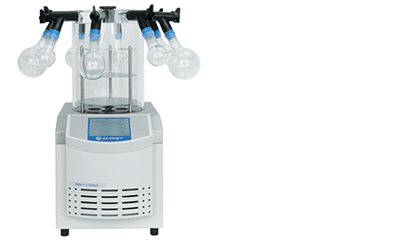
Freeze dryer
To preserve the organic matter from degradation, the samples were dried by freeze-drying (Christ Alpha 1-2 LSC Basic) before being homogenised by grinding in an agate mortar.
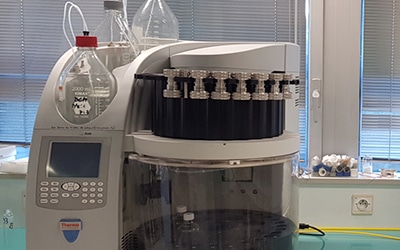
Organic solvent extractor
In order to analyse molecular compounds, they must first be extracted from the sediment. The technique used by the ASE 350 system (Accelerated Solvent Extractor, Thermo Scientific) is based on extracting molecules using organic solvents at high pressure and high temperature. The high temperature increases the solubility of the compounds in the solvent, while the high pressure maintains the solvent in a liquid state.
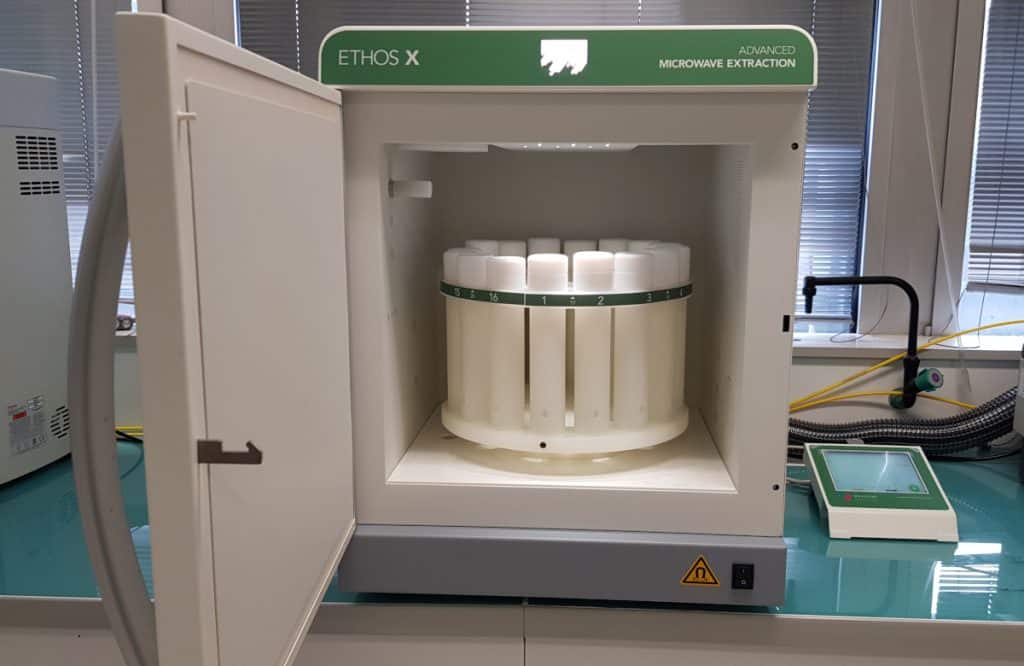
Organic microwave extractor
The principle of microwave extraction (MAE Microwave-Assisted Extraction ETHOS Milestone) is based on heating the sample with organic solvents in closed containers that can withstand high temperatures and pressures. Temperature increases the solubility of the compounds and reduces the viscosity of the solvent. The physical parameters (T°C, pressure, T°C ramp) of the extraction are measured and recorded continuously for reasons of traceability and safety. The advantage of MAE is that a large number of samples can be processed simultaneously and rapidly, because the heat transfer to the samples is direct (the polar solvent absorbs the energy of the µ-waves and transfers it immediately to the molecules in the sample).
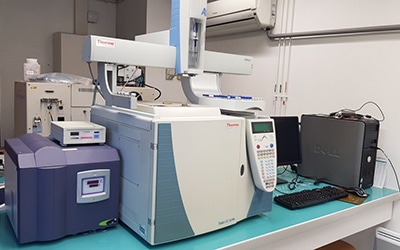
Gas chromatograph
Certain molecules can be separated, characterised and quantified by gas chromatography (GC). The instrument (Thermo Scientific Trace GC-FID) is equipped with a sample changer (Thermo Scientific TriPlus). Compounds are quantified using a flame ionisation detector (FID).
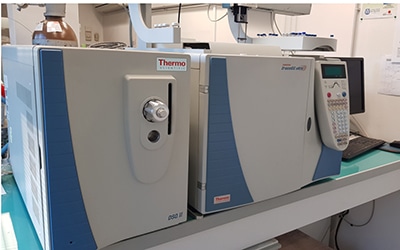
Gas chromatograph coupled to a quadrupole mass spectrometer
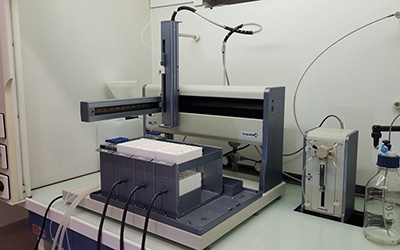
Solid phase chromatography robot
The preparation robot (Gilson GX-271) handles lipid extracts in liquid form, carrying out the separation of compounds by chromatography on SPE (Solid Phase Extraction) columns and collecting fractions of different polarities depending on the solvents. This sample preparation step carried out upstream of the separation of molecules by chromatography is essential for natural samples such as marine sediments in order to eliminate interfering compounds and simplify the matrix (Sanchi et al. 2013). Samples purified in this way are more suitable for analytical chromatography, which improves qualitative and quantitative analyses and increases the lifetime of chromatography columns by protecting them from irreversibly adsorbed contaminants.
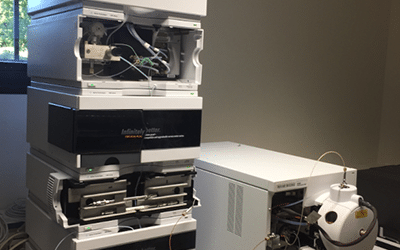
HPLC-MS system for the analysis of GDGT tetraethers
High performance liquid chromatography system coupled to a quadrupole mass spectrometer (HPLC-MS Agilent 1260) with an APCI (Atmospheric Pressure Chemical Ionisation) source. The system is also equipped with a UV detector, an electrospray source (ESI) and fraction collectors. The optimal configuration for GDGTs includes two tandem silica columns (Davtian et al. 2018).
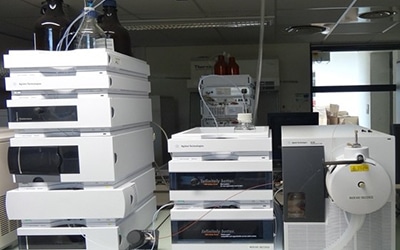
Preparatory HPLC-MS system for collecting molecular fractions
High performance liquid chromatography system coupled to a quadrupole mass spectrometer (HPLC-MS Agilent 1200) dedicated to the purification of certain biomarkers such as alkenones prior to D/H and 13C/12C (in collaboration with Guillaume Leduc) and radiocarbon dating. The analytical chain is equipped with a quaternary pump, an oven and a fraction collector. A splitter at the exit of the column allows the flow to be divided in order to collect 95% of the sample mass and to direct 5% to the mass spectrometer equipped with an APCI (Atmospheric Pressure Chemical Ionization) source. An isocratic pump is used to add sufficient solvent flow for the APCI source which is not compatible with micro-flow rates. The HPLC-MS-prep system was acquired with funding from the Collège de France and the ANR Isobioclim.
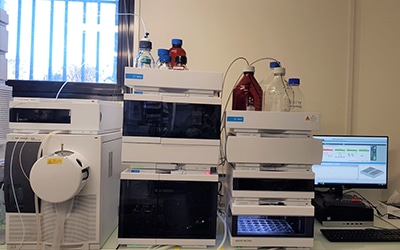
Preparatory HPLC system for amino acid collection
The preparative high performance liquid chromatography chain (HPLC-prep Agilent 1200) allows the isolation and collection of specific molecules such as amino acids (hydroxyproline in particular). The system is equipped with a UV detector and can be coupled to the quadrupole mass spectrometer of system n°7 (HPLC-MS dedicated to GDGTs) in order to verify the identification and purity of the compounds. The recovered fractions can then be analysed by other techniques. For example, it is possible to date the collected molecules by accelerator mass spectrometry (AMS) or to measure their d13C and d15N by isotope ratio mass spectrometry (IRMS). The HPLC-prep system was installed in 2022 thanks to funding from the Collège de France and the AMIDEX foundation.
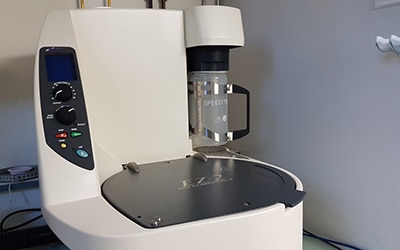
Genevac evaporator
The Genevac is a centrifugal concentrator capable of removing organic solvents, water and acids for various sample formats. The system therefore allows samples to be concentrated or completely dried. It is used, among others, in the amino acid extraction protocol prior to radiocarbon dating. The Genevac evaporator was acquired in 2022 thanks to funding from the Collège de France and APIC CEREGE.
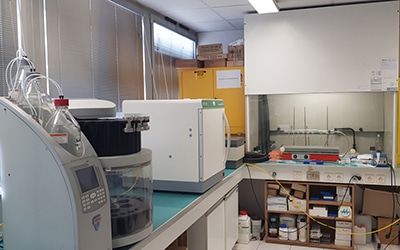
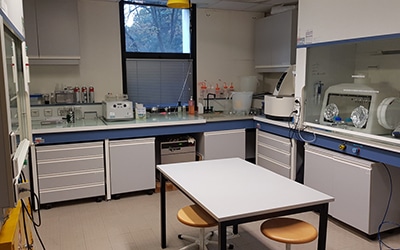
Chemistry rooms
The organic geochemistry unit has two chemistry rooms equipped to prepare samples for biomarker quantification by liquid and gas chromatography and to purify and characterise molecular fractions for radiocarbon measurements. These chemistry rooms are equipped with several fume cupboards and small benchtop equipment: Grinding equipment to increase the contact surface and favour the extraction of the lipid phase, balances and microbalance (XP6, Mettler Toledo), Centrifuge (5702, Eppendorf), muffle ovens used to calcine glassware to remove organic contamination, Milli-Q (millipore) pure and ultrapure water purification system, TurboVap (Biotage) and ReactiVap (Thermo Scientific) automated solvent evaporation system, thermostatically controlled stirring system (MR13, Hettich) to accelerate the extraction phases.

